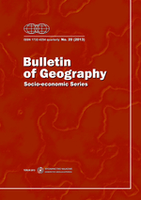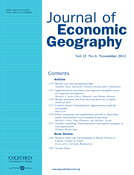
MITTEILUNGEN DER OSTERREICHISCHEN GEOGRAPHISCHEN GESELLSCHAFT
Scope & Guideline
Fostering Scholarly Discourse in Austrian Geography
Introduction
Aims and Scopes
- Regional Studies and Analysis:
The journal emphasizes the examination of specific regions, particularly in Central and Southeastern Europe, focusing on their geographical, socio-economic, and cultural characteristics. - Socio-Economic Geography:
A core area of focus involves analyzing economic activities, labor markets, and the impacts of globalization and crises on local economies. - Cultural Geography and Identity:
The intersection of geography with cultural studies is a recurring theme, particularly in exploring identity, place names, and the effects of migration. - Environmental Geography:
The journal also covers environmental issues, particularly in the context of climate change and sustainable development, highlighting human-environment interactions. - Urban and Rural Transformations:
Research on urbanization processes, rural development, and the dynamics of space usage, especially in the wake of socio-economic changes or crises, is a significant aspect of the journal's contributions.
Trending and Emerging
- Impact of COVID-19:
There has been an increasing focus on how the COVID-19 pandemic has affected demographic structures, urban spaces, and social behaviors, signaling a trend towards examining crises as catalysts for geographical change. - Migration and Integration Studies:
Research on migration patterns, refugee experiences, and integration strategies has gained prominence, highlighting the relevance of these themes in contemporary geographical discourse. - Urban Resilience and Transformation:
Emerging studies are concentrating on urban resilience, particularly how cities adapt to economic shifts and social changes, as well as the role of public spaces in urban settings. - Sustainability and Environmental Issues:
An increased emphasis on sustainability, particularly in the context of climate change and environmental governance, reflects a growing awareness of the need for interdisciplinary approaches to geographical problems. - Geosociology and Social Geography:
There is a notable trend towards integrating social theories with geographic inquiry, exploring how social relations and structures influence spatial dynamics.
Declining or Waning
- Historical Geography:
Research centered around historical geographical analysis, such as the historical development of regions or the impact of historical events on geographical landscapes, has become less frequent. - Tourism Geography:
Although tourism remains a relevant topic, specific studies directly addressing the commodification of tourism or critiques of tourism economies are appearing less often. - Geographical Education:
The focus on geographical education and pedagogical approaches, while still present, seems to be waning in favor of more applied geographical research related to current socio-economic issues.
Similar Journals

Geografie
Connecting diverse perspectives in geography and development.Geografie, published by the Czech Geographic Society, serves as a vital resource in the fields of geography, planning, and development. With an E-ISSN of 1212-0014, this esteemed journal has been contributing to the academic landscape since its inception in 1992, providing a platform for rigorous research and diverse perspectives on earth-surface processes and regional development issues. Based in the heart of Prague at Charles University, it has reached an impressive convergence of scholarly excellence, ranking in the Q3 category for both Earth-Surface Processes and Geography, Planning and Development as of 2023. Although it does not currently offer open access, the journal is indexed in Scopus, holding significant positions within its realms—392nd out of 821 in Social Sciences and 89th out of 179 in Earth and Planetary Sciences—indicating its relevance and contribution to ongoing discussions in both disciplines. As an indispensable tool for researchers, professionals, and students alike, Geografie not only enhances the understanding of spatial processes but also fosters innovative solutions for contemporary geographical challenges.

Geographical Research
Innovating the Landscape of Geographical ScholarshipGeographical Research, published by WILEY, is a premier academic journal based in the United Kingdom, dedicated to advancing knowledge in the fields of Geography, Planning, and Earth-Surface Processes. With an impact factor that reflects its high academic caliber, this journal ranks in the Q2 category for Earth-Surface Processes and Q1 in Geography, Planning and Development, highlighting its influential role in shaping contemporary research within these disciplines. The journal's Scopus rankings further underscore its significance, standing at #175 out of 821 in Geography, and #41 out of 179 in Earth-Surface Processes, placing it within the top 78th and 77th percentiles, respectively. Since its inception in 2005, Geographical Research has continuously provided a vital platform for scholars to disseminate innovative research, fostering dialogue and collaboration across disciplines. Although currently not open access, its content remains indispensable for researchers, professionals, and students aiming to deepen their understanding of geographical phenomena and develop strategic insights for planning and development.

Bulletin of Geography-Socio-Economic Series
Enhancing understanding through interdisciplinary insights.Bulletin of Geography-Socio-Economic Series, published by Nicolaus Copernicus University in Torun, Poland, is a premier Open Access journal dedicated to enhancing interdisciplinary discourse within the fields of geography and socio-economics. Since its inception in 2003, the journal has garnered significant recognition, achieving a Q1 ranking in Cultural Studies and notable placements in other categories, affirming its impact on the academic community. The journal provides valuable insights and research findings with the aim of fostering a deeper understanding of socio-economic trends and their geographical implications. Its commitment to Open Access since 2008 underscores its dedication to disseminating knowledge widely, making it an essential resource for researchers, professionals, and students alike. With an accessible online format and a solid reputation reflected in its impressive Scopus ranks, the Bulletin of Geography-Socio-Economic Series plays a pivotal role in shaping contemporary discussions in social sciences, facilitating knowledge exchange across borders.

JOURNAL OF ECONOMIC GEOGRAPHY
Innovating Research at the Intersection of Geography and EconomicsJOURNAL OF ECONOMIC GEOGRAPHY, published by Oxford University Press, is a premier academic journal that explores the intricate relationships between economic processes and geographic contexts. With an impressive impact factor positioning it within the Q1 category for both Economics and Geography, this journal serves as an essential resource for researchers, professionals, and students dedicated to the dynamic fields of economic geography and spatial analysis. Reaching audiences globally from the United Kingdom, it addresses critical themes such as regional development, resource distribution, and socio-economic transformations. The journal's coverage from 2001 to 2024 marks its commitment to advancing knowledge and fostering scholarly communication within the community. As a vital conduit for cutting-edge research and theoretical innovation, the JOURNAL OF ECONOMIC GEOGRAPHY continues to shape the academic landscape and inform decisions in various sectors.

Revista Geografica de America Central
Unveiling the Dynamics of Central American Landscapes.Revista Geografica de America Central is a distinguished scholarly journal published by the UNIV NACL, ESCUELA CIENCIAS GEOGRAFICAS, focusing on the dynamic field of geography, particularly within Central America. Since its inception in 1974, the journal has championed the dissemination of open-access research, fostering collaboration and innovation among researchers, professionals, and students alike. With an evolving scope that reflects the region's rich geographical diversity, this journal serves as a vital platform for sharing empirical studies, theoretical advancements, and methodological discussions that enhance our understanding of Central America's unique environmental and socio-economic challenges. Although it has experienced various coverage periods, the journal remains committed to advancing geographic scholarship and supporting open academic discourse. Its open-access model ensures that essential knowledge is readily available to an expanding global audience, making it an invaluable resource in the field.

Quaestiones Geographicae
Exploring the Boundaries of Geographical KnowledgeQuaestiones Geographicae, an esteemed open-access journal published by SCIENDO, serves as a vital platform for scholarly communication in the field of Earth and Planetary Sciences. Since its inception in 1979, the journal has been dedicated to promoting rigorous research and discourse in geography, encompassing a breadth of topics that reflect the dynamic nature of the discipline. With an impressive Impact Factor belonging to the Q3 quartile category, the journal actively contributes to the global scientific community's understanding of geographical phenomena. Its commitment to open-access publishing since 2010 ensures that groundbreaking research is accessible to a wider audience, facilitating collaboration and innovation. As part of its enduring legacy, Quaestiones Geographicae engages researchers, professionals, and students alike, inviting them to explore, share, and expand the boundaries of geographical knowledge.

Documents d Analisi Geografica
Connecting Scholars and Ideas in Geography and PlanningDocuments d'Anàlisi Geogràfica is a distinguished academic journal published by Universitat Autònoma de Barcelona, focusing on the fields of geography, planning, and earth-surface processes since its inception in 1988. With an Open Access policy implemented in 2012, the journal aims to facilitate the widespread dissemination of geographical research and insights, accessible to a global audience. Currently ranked in Q3 for both Earth-Surface Processes and Geography, Planning and Development categories, it serves as a vital platform for researchers, practitioners, and students to share their findings and enhance knowledge in these critical fields. The journal is indexed in Scopus, where it stands at rank #470 in Social Sciences and #106 in Earth and Planetary Sciences, reflecting its growing impact in relevant academic communities. Based in Barcelona, Spain, Documents d'Anàlisi Geogràfica continues to contribute substantially to geographical scholarship by exploring contemporary issues and advancements in a rapidly evolving world.

Geographia Cassoviensis
Advancing Knowledge in Geography and Planetary SciencesGeographia Cassoviensis, published by the Pavol Jozef Šafárik University, Faculty of Science, Institute of Geography, is a pivotal platform for scholarly exploration in the fields of Earth and Planetary Sciences and Geography. Established in 2016, this journal has rapidly developed into a valuable resource for researchers and practitioners seeking to understand the intricate facets of geographical and environmental dynamics. With an ISSN of 1337-6748 and an E-ISSN of 2454-0005, Geographia Cassoviensis is indexed in Scopus and holds a position in the Q4 quartile for both its submission categories as of 2023, reflecting its burgeoning impact within the scientific community. Located in Kosice, Slovakia, this journal invites contributions that further the discourse in geography, planning, and related environmental studies. Although currently not an open-access journal, it aims to foster a deeper understanding of geographical concepts and their applications across diverse realms, making it a vital resource for students, researchers, and professionals alike.

Miscellanea Geographica
Advancing Knowledge in Earth and Planetary SciencesMiscellanea Geographica, published by SCIENDO, is a prominent open-access journal established in Germany that contributes significantly to the fields of Earth and Planetary Sciences and Geography. With an ISSN of 0867-6046 and an E-ISSN of 2084-6118, this journal has been a platform for scholarly dissemination since 1984, encompassing a diverse range of interdisciplinary research areas. Since transitioning to open access in 2011, it has made its content widely available, enhancing visibility for researchers and practitioners across the globe. In the 2023 category quartiles, Miscellanea Geographica is ranked Q3 in both Earth and Planetary Sciences (miscellaneous) and Geography, Planning and Development, reflecting its commitment to quality scholarship. This journal is specifically designed to foster dialogue and collaboration among researchers, professionals, and students, making it a vital resource for those invested in the intricate relationships between geography and societal development. Researchers are encouraged to contribute groundbreaking studies that not only advance academic understanding but also address real-world challenges.

ZFW-Advances in Economic Geography
Advancing insights into spatial economic dynamics.ZFW-Advances in Economic Geography, published by WALTER DE GRUYTER GMBH, is an emerging academic journal dedicated to advancing research in the dynamic field of economic geography. With an ISSN of 2748-1956 and an E-ISSN of 2748-1964, this journal aims to provide a platform for innovative studies related to spatial economic interactions, regional development trends, and the impact of globalization on local markets. Since its inception, the journal has successfully garnered attention, achieving a commendable Scopus ranking with 69th percentile in Geography, Planning and Development and 65th percentile in Economics and Econometrics, affirming its relevance among scholars. Set to lead the discourse in economic geography from 2022 to 2024, ZFW encourages a diverse range of contributions, including empirical research, theoretical frameworks, and policy implications, to address the pressing challenges in the economic landscape. Although currently not open access, the journal's commitment to disseminating high-quality knowledge ensures its significance for researchers, professionals, and students alike, striving to deepen their understanding of the intricate relationships between geography and economics.